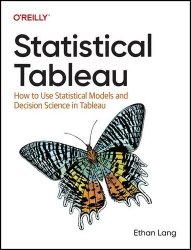 Название: Statistical Tableau: How to Use Statistical Models and Decision Science in Tableau Название: Statistical Tableau: How to Use Statistical Models and Decision Science in Tableau
Автор: Ethan Lang
Издательство: O’Reilly Media, Inc.
Год: 2024
Страниц: 314
Язык: английский
Формат: epub (true)
Размер: 24.4 MB
In today's data-driven world, understanding statistical models is crucial for effective analysis and decision making. Whether you're a beginner or an experienced user, this book equips you with the foundational knowledge to grasp and implement statistical models within Tableau. Gain the confidence to speak fluently about the models you employ, driving adoption of your insights and analysis across your organization.
As AI continues to revolutionize industries, possessing the skills to leverage statistical models is no longer optional—it's a necessity. Stay ahead of the curve and harness the full potential of your data by mastering the ability to interpret and utilize the insights generated by these models.
Whether you're a data enthusiast, analyst, or business professional, this book empowers you to navigate the ever-evolving landscape of data analytics with confidence and proficiency. Start your journey toward data mastery today.
Statistical analysis and data visualization are often considered two separate things. However, both disciplines rely on one another. To understand your data and make accurate predictions or assumptions through statistical analysis, you must visualize your data. On the other hand, to deliver actionable insights and enable your audience to get the most from data visualizations, we must back up our assumptions with some statistical analysis.
This book is to help you bring statistics into your visualizations in Tableau. You will learn how to read and interpret statistical models, implement them in Tableau, and ultimately draw out actionable insights to present to your stakeholders. Most decisions using data come with risks; it is your responsibility to arm the decision maker with as much information as possible and to mitigate those risks.
R is a programming language and open source software environment primarily used for statistical computing and graphics. It was developed by statisticians and data analysts to provide a versatile and powerful platform for data analysis, visualization, and statistical modeling. R is widely used in academia, industry, and research fields for tasks such as data manipulation, exploratory data analysis, hypothesis testing, Machine Learning, and more.
Python is a popular language in various fields, including web development (using frameworks like Django and Flask), Data Science and Machine Learning (with libraries like NumPy, Pandas, and Scikit-learn), and automation (with tools like Selenium and Beautiful Soup). Its versatility and simplicity have contributed to widespread adoption in the software development community.
In this book, you will learn:
• The basics of foundational statistical modeling with Tableau
• How to prove your analysis is statistically significant
• How to calculate and interpret confidence intervals
• Best practices for incorporating statistics into data visualizations
• How to connect external analytics resources from Tableau using R and Python
Contents:
Preface
1. Introduction
2. Overview of the Analytics Pane
3. Benchmarking in Tableau
4. Understanding Normal Distribution Using Histograms
5. Understanding Confidence Intervals
6. Anomaly Detection on Normally Distributed Data
7. Anomaly Detection on Nonnormalized Data
8. Linear Regression in Tableau
9. Polynomial Regression in Tableau
10. Forecasting in Tableau
11. Clustering in Tableau
12. Creating an External Connection to R Using Tableau
13. Creating an External Connection to Python Using Tableau
14. Understanding Multiple Linear Regression in R and Python
15. Using External Connections in Tableau
Index
Скачать Statistical Tableau: How to Use Statistical Models and Decision Science in Tableau
|